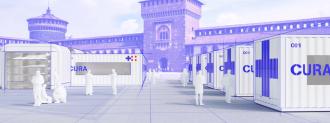As more and more people catch COVID-19, hospitals are finding themselves running out of room in intensive care units (ICUs) for severe patients.
Now, a group of designers, health experts, and engineers has teamed up on CURA (Connected Units for Respiratory Ailments), a nonprofit project that aims to address this shortage by creating new ICUs for coronavirus patients out of shipping containers.
ICUs for Coronavirus Patients
During the peak of Italy’s COVID-19 outbreak, hospital workers found themselves forced to turn away coronavirus patients as their ICUs quickly filled up.
Any patients who didn’t have the coronavirus prior to being admitted to the ICU, meanwhile, often contracted it during their hospital stays.
“We have lost some patients just because their bed was close to a sick patient and we did not know that he was Covid positive,” Marco Metra, chief of cardiology at Brescia’s University and City Hospitals, told the New York Times.
“You have these patients who came to the hospital one week ago to be treated for something else and they were infected and now they are sick,” he continued.
The United States is currently staring down the same issues Italy already faced, according to the daily COVID-19 projections produced by the Institute for Health Metrics and Evaluation, a University of Washington research center.
As of April 9, it projects a shortage of 9,000 ICU beds on the date the pandemic reaches its expected peak.
The potential shortage of beds in ICUs for coronavirus patients won’t be uniform across the nation, either — people in rural areas, in particular, could find themselves with nowhere to turn for treatment if they catch COVID-19.
“We have a lot of smaller hospitals around us,” Cynthia Jumper, a physician in Texas, told the Washington Post. “If our hospital’s full, what is a guy in Monahans, Texas, with two ICU beds and one ventilator going to do?”
So far, health officials have relied on either temporary tent hospitals or prefabricated hospital wards to address the lack of space in ICUs and the problem of coronavirus patients infecting others.
Tent hospitals are quick to construct, but not particularly effective at containing the coronavirus. Prefab wards are safer, in terms of biocontainment of the virus, but they can take weeks or months to complete.
CURA believes its shipping containers could provide the best of both options — with a couple of added benefits.
The Shipping Container Solution
With the help of more than 100 contributors, CURA came up with a design that converts a standard shipping container (8 feet by 8.5 feet by 20 feet) into an ICU for two coronavirus patients, complete with beds and any necessary medical equipment.
This system would be easy to scale-up as needed, according to CURA — just connect one shipping container ICU to another, via an inflatable corridor. An extractor could ensure negative air pressure within the unit, minimizing the risk of the virus spreading outside of it.
“The advantage of the shipping container is that the infrastructure for moving them already exists.”
Carlo Ratti
The shipping container ICUs for coronavirus patients would also be easy to deploy wherever traditional beds are in short supply, according to architect Carlo Ratti, one of the leaders of CURA.
“The waves of the virus travel to different regions so quickly, so we need to be able to deploy the intensive care units wherever they are needed most,” he told The Guardian. “The advantage of the shipping container is that the infrastructure for moving them already exists.”
CURA is currently building a prototype in Turin. It plans to deploy that prototype at a hospital in Milan, but has made the design blueprints available for free online so anyone can use them.
Ratti estimates it’ll cost $100,000 to convert each shipping container, including all of the medical equipment.
The per-bed cost of building an emergency prefabricated hospital is about three times that — meaning this could be a cost-effective, safe solution to the shortage of ICU beds in the U.S. and beyond.





